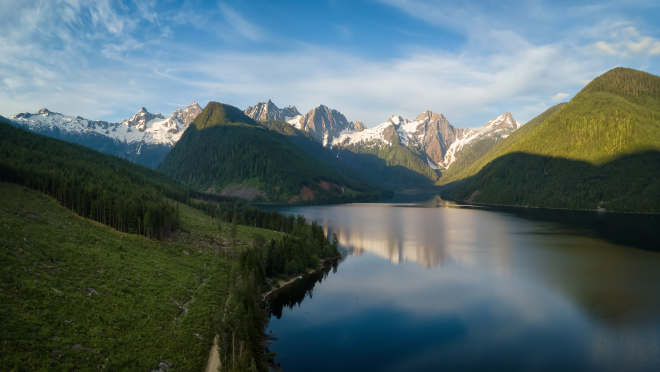6 ideas for growing a drought tolerant garden

Know your microclimate, and watch your garden grow
It might not be the garden or patio of your dreams, and it might not look quite like anything you've envisioned. But with a little research and experimentation, your plants can thrive in a time of record high and low temperatures, drought, and water restrictions.
We sat down with Vancouver-based landscape architect Gerry Eckford to discuss how a changing climate and changing attitudes towards ornamental gardens are evolving approaches to gardens in our province. While recognizing that August is not the time to start planting much beyond fall harvest veggies such as arugula, kale, and winter lettuce, it's never too early to plan.
Here are six ideas to consider in mapping out a beautiful, resilient garden.
Save what you can, and learn to water effectively
You may already have some hardy plants in the mix. As the drought continues, use water wisely to ensure their continued health.
Water your plants slowly, in the morning, by hand, near the roots. Break up hardened dirt to allow water to soak in, and consider adding mulch to your gardens, as it shades soil and helps conserve soil moisture.
While you're at it, consider watering city-owned street trees in your neighbourhood. The City of Vancouver recommends slowly pouring a bucket of water around the base of thirsty trees twice a week, ideally in the evening to reduce evaporation.
Learn about your plant hardiness zone
When considering plants for around your home, start with the basics. Consult a local gardening shop or go online to find which of North America's plant hardiness zones you're in. Originally developed by the U.S. Department of Agriculture (USDE), hardiness zone maps are primarily based on low temperatures and the ability of plants to survive at those temperatures. But climate change and local conditions – including record low and high temperatures in recent years – can imperil plants that used to thrive in B.C.
The best advice is to talk to at expert at your local garden shop – they'll help steer you in the right direction around specific plant choices that are suitable for your specific area.
Consider drought resilience and other factors
Landscape architect Eckford says to consider the drought tolerance of plants, but only as part of a larger puzzle.
"Step back and consider other climate factors, because water isn't the only issue," he says. "A lot of other things can also cause stress on a plant, and when a plant is under stress, it has less ability to tolerate drought."
Look into soil type and quality, sunlight exposure, humidity, wind exposure, pests, and diseases. Also consider local wildlife, as animals such as deer and rabbits prefer certain plants.
"It's also important to anticipate climate change by using more tolerant plants rather than ones on the edge," adds Eckford. "Droughts, late-season frost and this past January's record low temperatures are a warning call."
Learn about drought tolerant species, and visit a xeriscape demo garden
Look online for ideas of drought-tolerant species for your area, and there's a good chance you'll find a lot of the species on this list: broadleaf stonecrop, Meadow sage, purple coneflower, lamb's ear, hens and chicks, yarrow.
"Almost all of these species grow in free-draining soils and adapt to fighting for a little bit of moisture," says Eckford. "Stonecrop, for example, literally grows on top of a rock and survives. It has a fleshy leaf that stores water. Others have incredibly long, deep roots that go down much deeper for water."
You can also learn a lot from a visit to a xeriscape garden, which is designed to reduce or completely eliminate the need for watering. Demonstration gardens can be found in B.C. cities including Castlegar, Penticton, Vernon, Kelowna, West Kelowna, Summerland, Osoyoos, Kamloops, and Victoria.
Look beyond the flowery English garden
You may like the idea of an English style garden as much as you adore your British TV dramas. Perhaps it's time to consider a different aesthetic (at least with your plants).
“We’re going through a change in our aesthetic expectations,” says Eckford. “Traditionally, many British Columbian gardeners came from a European garden culture, and we may expect this beautiful floral arrangement. But there’s a slow shift to a more ecological attitude towards planting with an acceptance of a little more messiness. Not only are these plants more adaptive, they allow for more biodiversity than a straight ornamental garden. They are habitats and food sources for birds and bees and bugs.”
Ask yourself if you really need a lawn… or downsize it
A lot of us grew up with lawns and assumed that we'd always have one in the backyard. They can be a great place for the kids to play and can have a significant cooling effect on a yard, but they are incredibly thirsty. If you have a lawn, let it go brown (it will bounce back) when water restrictions are in effect, and if you get tired of looking at a brown lawn, consider the alternatives.
Eckford says the movement towards wild, drought tolerant lawns populated with wildflowers and native species is off to a slow start in B.C. If you'd consider a switch, look for local eco-friendly lawn resources such as Metro Vancouver's growngreenguide.ca. If not, consider taking out your lawn or reducing its size.
"Maybe you design for a little bit of a lawn with more biodiversity around the edges, and slowly wean yourself off it," he says.
Related:
